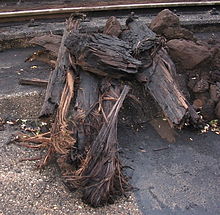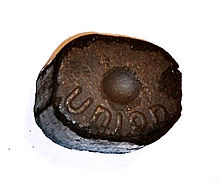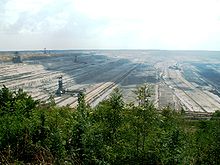Brown coal

Lignite (formerly also called turf ) is a brownish-black, mostly loose sedimentary rock , which was created under pressure and in the absence of air through the carbonization of organic substances. Lignite is a fossil fuel that is used to generate energy . Raw lignite has around a third of the calorific value of hard coal , which corresponds to around 8 MJ or 2.2 kWh per kilogram. Processed (dried) lignite has about two thirds of the calorific value of hard coal.
Emergence

Most of the lignite stored in Germany originated in the Tertiary , the geological time around 65 to 2 million years ago. The coal in Lausitz and the Rhineland originated in the Miocene (5 to 25 million years ago), that around Helmstedt and Leipzig 50 to 60 million years ago.
In other countries there are coal in much older formations, which are similar in their physical and chemical properties to lignite ( Alpine valleys , Alpine foothills).
As with coal , organic material from dead plants , e.g. B. Trees and bushes, initially as peat in moors and, after being covered with sediments, went through the geochemical process of coalification under pressure and in the absence of air .
Lignite is less carbonated than hard coal. It has a higher sulfur content and a coarser, looser and more porous base. This sometimes contains large stump horizons (sometimes whole tree stumps , see adjacent picture).
Chemical composition
In the case of ash - and anhydrous coal, one can speak of lignite if the carbon content is between 58 and 73%, the oxygen content is between 21 and 36% and the hydrogen content is between 4.5 and 8.5%.
In the Rhenish district , lignite contains a maximum of 0.5 percent sulfur, in the Lusatian lignite district 0.2 to 1.5 percent. In the Central German lignite mining area it is a maximum of 2.1 percent and in the Helmstedt lignite mining area (in operation until August 2016) it was up to 2.5 percent sulfur. In addition, brown coal contains small amounts of various trace elements.
Raw lignite consists of about 55% water, 5% (2… 20%) non-combustible components and 40% coal.
species
About the external properties of the lignite this is in:
- Soft lignite,
- Hard lignite,
- Matt brown coal and
- Luster brown coal
assigned.
Another classification is based on their petrographic and technical properties
- xylitic charcoal ,
- Bituminous coal ,
- Steam coal ,
- Briquetting charcoal ,
- Brown coal coke ,
- Black coal and
- Brine .
Economical meaning
Stocks
In 2006 the Federal Institute for Geosciences and Raw Materials (BGR) estimated the reserves that could be economically recovered worldwide at the prices at that time at 283.2 billion tons of lignite, of which 32.3 percent (91.6 billion tons) in Russia, 14.4 percent (40.8 billion tons) in Germany and 13.3 percent (37.7 billion tons) in Australia. If production remained the same (966.8 million tons in 2006), demand could be met by 2300.
In Germany, according to the BGR, with constant production (176.3 million tons in 2006), the reserves would be sufficient for 231 years. In 2012, the lignite reserves in Germany amounted to 40.4 billion tons and the resources to 35.2 billion tons (definition: resources = the proven amount of lignite that cannot currently be extracted technically and / or economically , as well as the undetected but geologically possible , future recoverable amount of a brown coal deposit).
advancement
Around 1.1 billion tons of lignite were mined worldwide in 2012. Germany (16.8 percent), the People's Republic of China (13.1 percent), Russia (7.0 percent), Turkey (6.8 percent) and the United States (6.5 percent) fund around half of this. Other large lignite mining areas in Europe are in Poland , the Czech Republic and Southeastern Europe .
In Germany there are three large brown coal districts : the Rhenish in the Lower Rhine Bay , the Central German (see also: Mitteldeutsche Strasse der Braunohle ) and the Lusatian district . The Helmstedt brown coal area and other smaller areas in the Upper Palatinate (including near Wackersdorf ) as well as in North and Central Hesse ( Borken , in the Wetterau , in the Kaufunger Forest near Großalmerode / Hirschberg or on the Hohe Meißner ) have now been charred.
The largest German lignite company is RWE Power AG (formerly RWE Rheinbraun AG) based in Essen and Cologne .
In Austria u. a. in the federal state of Upper Austria until the mid-1990s in Ampflwang ( Hausruck ) and Trimmelkam ( Salzach coal mining ) lignite was mined underground. In western Styria , underground mining was operated in Fohnsdorf until 1978, in the Voitsberg district in Zangtal and in Rosental an der Kainach until 1990 and the Oberdorf-Bärnbach opencast mine until 2004. The Langau-Riegersburg open-cast lignite mine in Lower Austria was ended in 1963.
| rank | country | Production (in million t ) |
rank | country | Production (in million t) |
|---|---|---|---|---|---|
| 1 |
|
171.3 | 11 |
|
39.3 |
| 2 |
|
145.0 | 12 |
|
37.8 |
| 3 |
|
75.0 | 13 |
|
34.4 |
| 4th |
|
74.1 | 14th |
|
25.7 |
| 5 |
|
63.6 | 15th |
|
16.3 |
| 6th |
|
61.2 | 16 |
|
14.0 |
| 7th |
|
60.0 | 17th |
|
13.4 |
| 8th |
|
56.1 | 18th |
|
9.2 |
| 9 |
|
46.7 | 19th |
|
8.0 |
| 10 |
|
39.8 | 20th |
|
7.6 |
1 Also contains hard lignite mining
With up to 300 million tons of annual production, the GDR was at the top of the production countries worldwide until the end of the 1980s.

If you would like to see a detailed map of the world on mining "freely movable" in large format (5.6 MB), follow this link
processing

The varieties with a high proportion of volatile components can be processed into lignite coke in coking plants . Depending on the temperature of the process, Schwel- or Grudekoks are obtained . Lignite coke is primarily used on an industrial scale for filtration , the material replacing the activated charcoal made of wood, which is customary on a laboratory scale . In addition, raw lignite is processed into various solid fuels (briquettes, lignite dust, fluidized bed lignite) in coal refining plants by crushing, drying and shaping it .
In Germany, RWE Power AG and Vattenfall Europe Mining AG (formerly Lausitzer Braunkohle AG ) produce lignite briquettes . RWE sells its briquettes under the trade name Union-Brikett and Vattenfall under the name Rekord-Brikett .
use
Today (2017) lignite - ground and dried - is 90 percent used as fuel for electricity generation . The remaining 10 percent are z. B. processed into briquettes . Lignite, which is particularly rich in bitumen, is used to produce montan wax . To a lesser extent, lignite is marketed as a soil substrate as a substitute for bark mulch .
In 2010, the primary energy consumption of lignite was 1,637 PJ (= almost 12 percent of the primary energy consumption in the Federal Republic of Germany (13,645 PJ)). In 2016 it was 1,519 PJ and in 2017 1,510 PJ.
environmental issues
The extraction of lignite causes profound interventions in the ecology of the mining areas . It is desirable to minimize the anthropogenic influences through forward-looking environmental planning and to use energy resources efficiently.
The IPCC (Intergovernmental Panel on Climate Change, IPCC) calls for a rapid and fundamental transformation of global energy supply, in order to prevent profound climate change. This also includes phasing out the generation of electricity from lignite . Electricity generation from lignite rose slightly across the EU in 2017, however, a move away from lignite generation has not yet been identified.
Extraction and remediation

Brown coal in significant quantities in Europe today exclusively in the open pit mined. The extraction of lignite in opencast mining is associated with a high level of land consumption . These areas will be recultivated after they have been used by the mining company . Areas are reforested and / or returned to agriculture through targeted cultivation. Remaining holes are usually flooded and transformed into lakes with tourist use ( Leipziger Neuseenland , Villeseen ).
In order to be able to recover deposits as completely as possible , in accordance with German mining law , entire villages are relocated and dredged ( devastated ), which can lead to conflicts with the population (see also list of excavated towns ).
Lignite used to be mined on a large scale in all German lignite mining areas in civil engineering . With increasing mechanization, the importance of mining shifted to open-cast mining. The advantage in civil engineering was the selective extraction of different types of coal, etc. a. for the chemical industry. The focus here was the central German area around Halle. As a rule, the mining companies concluded a lease agreement with the owners of the land, which provided for the restoration of the land for agricultural use after the mining had ended. The fracture fields above the dismantled field parts were therefore leveled and returned to the owners. This process was not always free of conflict.
According to a study published in 2016, the provisions made by energy companies for the rehabilitation of open-cast lignite mines are set too low and are not available in an emergency.
Air pollution
Air pollutants
Lignite power plants emit various pollutants, some of which are released into the environment despite exhaust gas filtering. These include B. various heavy metals, mercury and fine dust . In comparison to hard coal, German lignite contains only about a third of the radioactive elements uranium , thorium and radium .
Appropriate technical precautions have so far been able to reduce emissions of sulfur dioxide and fly ash in particular . The fly ash is in modern power plants z. B. separated by electrostatic precipitators to 99.5%. The sulfur dioxide is separated to 90% by the flue gas desulphurisation , whereby large amounts of gypsum are produced as a by-product , which is mainly used by the construction industry.
Climate relevance
When burning lignite, carbon dioxide is inevitably produced . Lignite power plants, like all power plants based on fossil energy sources , release the carbon stored in the fuel into the atmosphere in the form of carbon dioxide when they are burned. In addition, large amounts of water vapor are generated in power plants. The released quantities of carbon dioxide and water vapor are important greenhouse gases as drivers of global warming . With a share of 77%, carbon dioxide is the most important greenhouse gas released by human influence. If the proportion of CO 2 in the atmosphere doubles compared to the pre-industrial value of 280 ppm, a temperature increase of between 2 and 6 ° C by the year 2100 can be expected according to the IPCC's Fourth Assessment Report .
Since the carbon contained in the fuel for energy conversion is completely converted into carbon dioxide with optimal combustion, the release of carbon dioxide cannot be prevented in such power plants due to the principle, but can only be reduced for the time being through better efficiency of the power plants and thus lower coal consumption. Nevertheless, the carbon dioxide emissions of lignite -fired power plants of 980–1230 g CO 2 / kWh are fuel- related, significantly higher than with other fossil-fired power plants (see also: coal-fired power plant ). Modern gas and steam combined cycle power plants with 410-430 g CO 2 / kWh z. B. only around a third of the carbon dioxide from lignite power plants.
Lignite power plants account for around half of the carbon dioxide emissions caused by electricity generation in Germany, while the share of lignite in electricity generation is only around a quarter (values apply to 2011). This results in approximately 3 times as high CO 2 emissions per generated kWh for lignite as for the average of the other energy sources used to generate electricity.
The proposed and projected separation of CO 2 ( CCS - Carbon Capture and Storage) in "carbon dioxide-free" power plants is associated with technical, energetic and financial expenditure, which reduces efficiency and thus increases coal consumption. In 2008 , the energy company Vattenfall built a test facility for carbon dioxide separation in the Brandenburg town of Schwarze Pumpe . Original plans to store the carbon dioxide captured in this way underground were given up again by German politicians because of resistance from the population and “lack of will” to implement it. The CCS technology is controversial, as the efficiency of the power plants falls as a result and the safe whereabouts of the CO 2 cannot finally be guaranteed.
literature
- Hans-Georg Schäfer: Origin and development of the thermal refinement of brown coal . In: Chemiker-Zeitung . tape 115 , no. 1 , 1991, ISSN 0009-2894 , pp. 19-24 .
- Wirtschaftsvereinigung Bergbau (Hrsg.): The mining manual . 5th edition. Glückauf, Essen 1994, ISBN 3-7739-0567-X .
- Friedrich H. Franke, Klaus J. Gunstermann, Michael J. Paersch: Coal and Environment Comment = mining, raw materials, energy. tape 26 . Glückauf, Essen 1989, ISBN 3-7739-0518-1 .
- Thole, Bernhard (1993) Lignite as an energy resource. The Earth Sciences; 11, 2; 50-58; doi: 10.2312 / geosciences . 1993.11.50 .
See also
Web links
- Federal Institute for Geosciences and Raw Materials
- Lignite extraction in the Hambach opencast mine, Rhineland
- BUND North Rhine-Westphalia - negative effects of the lignite industry in NRW
- Environmental lexicon: brown coal
- More detailed world map on mining "freely movable" in large format (5.6 MB)
Footnotes
- ^ The resource lignite. (No longer available online.) Deutscher Braunkohlen-Industrie-Verein eV , archived from the original on February 21, 2014 ; Retrieved February 3, 2014 . Info: The archive link was inserted automatically and has not yet been checked. Please check the original and archive link according to the instructions and then remove this notice.
- ↑ a b c Wirtschaftsvereinigung Bergbau (Ed.): The mining manual . 5th edition. Glückauf, Essen 1994, ISBN 3-7739-0567-X , brown coal, p. 181 .
- ↑ gvst.de ( Memento of the original from April 2, 2018 in the Internet Archive ) Info: The archive link was inserted automatically and has not yet been checked. Please check the original and archive link according to the instructions and then remove this notice.
- ↑ braunkohle-wissen.de ( Memento of the original from April 2, 2018 in the Internet Archive ) Info: The archive link was automatically inserted and not yet checked. Please check the original and archive link according to the instructions and then remove this notice.
- ↑ Reserves, resources and availability of energy resources 2013. (PDF 11.5MB) Federal Institute for Geosciences and Natural Resources (BGR), p. 88 , accessed on December 6, 2014 .
- ↑ according to the section Mining in West Styria on the website of the Karl-Schacht Mining Museum, accessed on March 15, 2019.
- ↑ BGR Energy Study 2018. Data and developments in German and global energy supply. Federal Institute for Geosciences and Natural Resources, p. 140 , accessed on August 21, 2019 .
- ↑ Energy consumption in Germany in 2017 , p. 26.
- ↑ Engelbert Weiß: Lignite should replace agricultural chemistry on www.mittelbayerische.de, September 29, 2015
- ↑ Energy consumption in Germany in 2012. (PDF) Arbeitsgemeinschaft Energiebilanzen , p. 2 , accessed on February 3, 2014 .
- ↑ Energy consumption in Germany in 2017 , p. 26.
- ^ IPCC, Working Group 3, Summary for Policymakers
- ↑ 2017: For the first time more electricity from wind, sun and biomass than from coal in the European Union In: agora-energiewende.de , January 30, 2018, accessed on January 31, 2018.
- ↑ Michael Haubofd-Rosar, Anke Schwarzenberg: Agricultural recultivation in the Jänschwalde open-cast lignite mine by Vattenfall Europe Mining AG. (PDF 2.5MB) Retrieved February 3, 2014 .
- ↑ P. Franke et al .: 25 years of Carl Adolph Riebeck . 50 years of A. Riebeck'sche Montanwerke Aktiengesellschaft 1858 - 1933. Munich 1933.
- ^ German Brown Coal Industry Association (Ed.): 50 Years of Central German Brown Coal Mining . Festschrift for the 50th anniversary of the German Brown Coal Industry Association 1885–1935. First edition. Knapp, Halle 1935, p. 600 .
- ^ Otfried Wagenbreth : The lignite industry in Central Germany . Geology, history, material evidence. 1st edition. Sax, Markkleeberg 2011, ISBN 978-3-86729-058-6 , pp. 352 .
- ^ FÖS / IASS: Financial provisions in the lignite sector. Options to secure provisions for lignite and to implement the polluter pays principle. 2016 ( Memento of the original from December 4, 2016 in the Internet Archive ) Info: The archive link was inserted automatically and has not yet been checked. Please check the original and archive link according to the instructions and then remove this notice.
- ↑ a b Response of the federal government to a small question on the future of coal-fired power generation. (PDF; 447kB) German Bundestag , May 5, 2008, p. 10 , accessed on March 23, 2019 .
- ↑ Valentin Crastan , Electrical Energy Supply 2 , Berlin Heidelberg 2012, p. 19f.
- ↑ Christopher Schrader: CO2 emissions. Climate balance of the power plants. In: Süddeutsche Zeitung . sueddeutsche.de, March 8, 2007, accessed January 20, 2015 .
- ↑ CO 2 balances of different energy sources in comparison. (PDF 1.1MB) German Bundestag - Scientific Services, pp. 20–21 , archived from the original on November 21, 2010 ; Retrieved February 3, 2014 .
- ↑ Vattenfall stops billions in CO2 storage project. In: Spiegel online . December 5, 2011, accessed February 3, 2014 .
- ↑ Researchers question the safety and efficiency of CCS technology. In: Märkische Oderzeitung . June 4, 2010, accessed April 21, 2012 .






